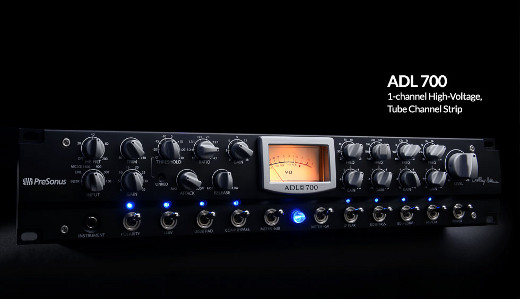PreSonus ADL 700 Channel Strip Now Shipping — Tube Pre, FET Compressor, 4-Band EQ
They say good things come to those who wait.
By that measure, the PreSonus ADL 700 Channel Strip, the latest in its ADL line of gear designed by the top tube-circuit designer Anthony DeMaria, should be very good indeed. Announced last July with a projected ship date of Q4 2012, the unit is finally officially available, for the promised street price of $1,999.
See and hear a huge rack of ADL 700’s in action here, with singer Briana Tyson and a live band. The full details on PreSonus’ long-awaited release follow below the video.
With its extensive feature set, ultra-low noise (-100 dB S/N ratio), >73 dB gain, extended frequency response of 10 Hz to 45 kHz, and top-of-the-line sound, the ADL 700 was designed with serious recording engineers and musicians in mind.
The ADL 700 combines a high-end Class A tube preamplifier with a fully variable, FET-based compressor and a four-band semi-parametric equalizer. This new channel strip provides separate balanced XLR mic, balanced XLR line, and ¼” TS instrument inputs and a single balanced XLR output.
The ADL 700 incorporates a single-channel version of the award-winning PreSonus ADL 600 two-channel tube preamplifier, which was designed by DeMaria.
For the ADL 700, PreSonus and DeMaria teamed up to create a distinctive Class A, discrete design. It incorporates one 12AT7 and two 6922 vacuum tubes per channel, operating with ±300V power rails for maximum headroom and “superb” tone.
The dual-transformer design ensures low-noise operation, with maximum common-mode rejection. The result is an ultra-low-noise tube preamp with a big, warm, smooth, clear, and distinctive sound.
Among the hallmark features of ADL-series preamps is an Input Source Select switch with variable mic-input impedance. This switch enables users to choose among signal sources and patches the selected input through the signal chain, completely bypassing the other two inputs. It also provides a choice of four mic-input impedances: 1500O, 900O, 300O, and 150O. Lowering or raising the ADL 700 mic-input impedance can create subtle coloring and filtering effects, enabling users to get a wider variety of tonalities without using the EQ.
The ADL 700′s FET-based compressor and semi-parametric EQ were custom-designed by Robert Creel, the designer behind many of PreSonus’ best selling analog circuits, including the XMAX preamp.
FET (Field-Effect Transistor) compressors use transistors to emulate a triode-tube sound. This type of compressor generally provides a faster attack time and better repeatability than the optical compressors that are more commonly found in channel strips in this price class.
The ADL 700 compressor features include fully variable attack, release, threshold, ratio, makeup gain, and bypass. When Threshold is turned fully counterclockwise to the ST position, the onboard compressor controls are bypassed, and compression is controlled externally via a Stereo Link connection to a second ADL 700.
The preamp offers 48V phantom power, polarity reverse, and a -20 dB pad. In addition, it provides variable mic-input gain, employing an 8-position rotary switch that provides 35 dB of gain in 5 dB increments. A Trim potentiometer (±30 dB) allows users to make fine adjustments to the final preamp stage of the ADL 700 input.
Users also get a -12 dB/octave high-pass filter whose frequency threshold can be set at 20 Hz, 40 Hz, 80 Hz, or 200 Hz, or it can be turned off completely.
The highly musical 4-band semi-parametric EQ combines isolated filters and optimized, per-band Q to provide subtler signal shaping without harsh artifacts. All bands have Gain (±16 dB) and Frequency controls, with overlapping frequency ranges and fixed Q (0.6). The low and high bands are switchable between shelving and peak.
Dual-mode analog VU metering enables monitoring of output and gain-reduction levels. A -6 dB switch offsets the meter for use with hot source signals. A master level control adjusts the overall output from -80 to +6 dB.
Please note: When you buy products through links on this page, we may earn an affiliate commission.







